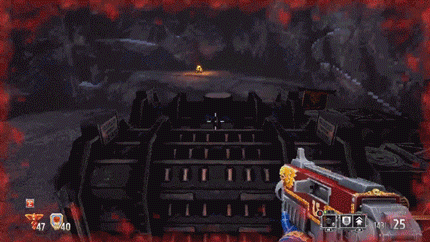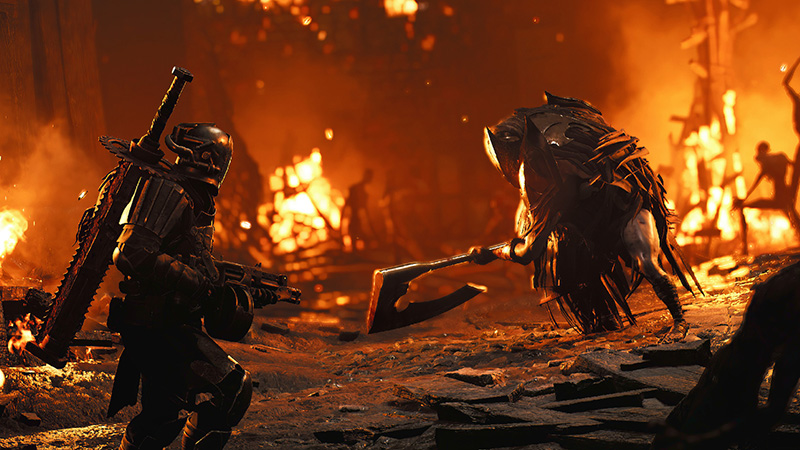- Signposted
- Posts
- Signposted #4
Signposted #4
Featuring Boltgun & the Best of Game Design
Currently pallet cleansing with: Mario Kart 8 DLC
Hey Designer,
Welcome to issue #4 of Signposted!
In this issue we’ll be discussing Boltgun and how the chainsword mechanics make it a compliment to the game’s ranged combat.
In the best of series, we’re looking at some answers to level design questions you’ve always wanted to ask. We’ll be chatting with Tim Cain, a director on Outer Worlds as well as one of the creators of Fallout, regarding his thoughts on durability mechanics. Then we’ll finish up with an interview with the Night School Studio founders. Where they discuss how their design has evolved over the years since Oxenfree. It’s a spiritual successor to the podcast episode in the Signposted welcome letter.
Last but not least, the results of last week’s community poll are in, console wars have been decided! For a while PS5 and PC were neck and neck, but a flood of votes came in at the 11th hour for mobile as the superior gaming platform! With 50% of the vote, mobile came out on top, with a tie for second between PC and PS5. Thank you everyone for participating! In this issue’s poll we’ll try to predict the fate of Unity.
Let’s get started!
Bi-Weekly Analysis
Mini Mechanic Microscope: Boltgun - The Chainsword
By Scott Fine
A frequent mistake in shooters is making melee or ranged too powerful so the player only engages with one, typically ranged. But Boltgun promotes the player bouncing back and forth, each having their place, and neither becoming the dominant strategy.
Let’s dive into how the chainsword in Boltgun works. As per usual, after the link to the full article is a quick breakdown of the most important points.
Quick Takeaway:
The chainsword is a combat and movement tool
Chainsword UI and Controls
All chainsword functionality is triggered via a single button
When pressed it revs the chainsword
This slows down time temporarily
It also highlights enemies which are within lunging range and roughly in front of the player
Players can turn while time is slowed to highlight a different enemy thus selecting a different target

Upon releasing the button they will lunge closing the distance and slicing the enemy
Expanding on the Functionality
There are two primary ways to use the chainsword
Rev the chainsword, and lunge into melee range at the target
Continuous melee attack - After making contact with the enemy, players can mash the chainsword button over and over again to continuously chainsaw an enemy to do damage beyond the initial strike
Tougher enemies can break out and push the player back, allowing said enemy to retreat or press their own attack
This is useful because it breaks up the chainsawing by preventing the player from lunging without a second thought at every enemy they encounter, requiring them to think about which ones would be better to shoot from afar.
How the chainsword impacts the primary gameplay
Combat
Great for chaff enemies
Allows player to save ammo
Allows player to lock up more powerful enemies temporarily
This helps keep the player alive from their shots
In combination with guns
Dedicated button and unlimited ammo allows the player to bounce back and forth between guns and chainsword
Allows player to soften up enemy then finish them off up close
Movement
Lunge closes the gap quickly
Without lunge the chainsword would not be useful as the player would need to be right next to an enemy to use it
With lunge + locking up enemies it keeps enemies from shooting the player, thus the player lives longer
Also creates shortcuts as players can clear larger chasms or reach higher platforms with enemies on it
Since it can only be used on enemies, it becomes easy for designers to control where the player can get the extra distance to
This little mechanic allows the player to feel clever and rewarded
The Best of Game Design
Disclaimer: All of the following articles, podcasts, and videos are not written, made, or owned by me. I am only curating, commenting on, and highlighting the best game design work I can find from mostly recent posts.
The Best of Written
Design lessons from the procedural puzzle pieces of Remnant II
By Bryant Francis
This is an interesting piece from Game Developer where they interview the creative director of Remnant 2, David Adams. He discusses procedural generation of the game, thus creating an infinitely repayable experience. He also walks through some of the design challenges the team faced as a result. While procedural generation is difficult to pull off, they seem to have done just that sitting currently at an 80 on Metacritic.
Guide for Creating Hybrid-Casual Games That Succeed - Udonis
By Andrea Knezovic
Hybrid-Casual games are all the rage in the mobile space. But making one is not quite as simple as it sounds. In this article Andrea walks through the choices designers must face while making a Hybrid-Casual game. If you’re interested in making your own, or understanding the challenges you’ll face, this is a great read.
Bonus Article: Answers to the level design questions you’ve always wanted to ask
By Vasiliy Skobelev
This issues’ bonus content almost became the top pick. But technically it isn’t one article, it’s a series of them! This is the final article in Vasiliy’s, the Lead Level Design at MY.GAMES, series on level design. It’s an in depth series and I highly recommend anyone interested in or looking to sharpen their chops take a read. And don’t worry, all the previous ones are linked to in the beginning of this article.
Issue #4 Community Question
The Best of Video
🏆Issue #4 Scott’s Top Pick!🏆- Durability Mechanics
By Timothy Cain
Tim Cain is one of the developers responsible for the Fallout series, as well as a Director of Outer Worlds. He is arguably one of the top game developers of all time. When he’s not creating memorable experiences, he is making daily game developer videos. In this one he very quickly breaks down durability systems and discusses their purpose in modern games. It’s riddled with systems logic and is a great watch.
Why Do We STILL Hate Tutorials?
By Adam Millard
Adam Millard breaks down why tutorials in modern games don’t work. He analyzes the different ways we learn in games and discusses when it is appropriate to use each of them. It’s a great analysis of tutorials and will be helping me to better teach my players going forward.
Note: If you have a blog, podcast, or video channel you would like to be considered for the Bi-Weekly Best of Series, please send me a link and I’ll add it to the feed.
The Best of Audio
Creating Complex Conversation Systems in Oxenfree II: Lost Signals
By Xalavier Nelson Jr
In the Signposted welcome email there is a link to a Game Developer podcast discussing Oxenfree and the narrative systems behind it. Years later, we’re getting a spiritual successor to that podcast episode thanks to Xalavier and the AIAS team. This podcast is even better if you listened to the one in the welcome letter first, but is still pack filled with interesting knowledge if you haven’t.
And that’s it for Signposted #4. Thanks for reading!
Scott
If you find a typo in the newsletter, please reply to shame me into improving my editing skills.




